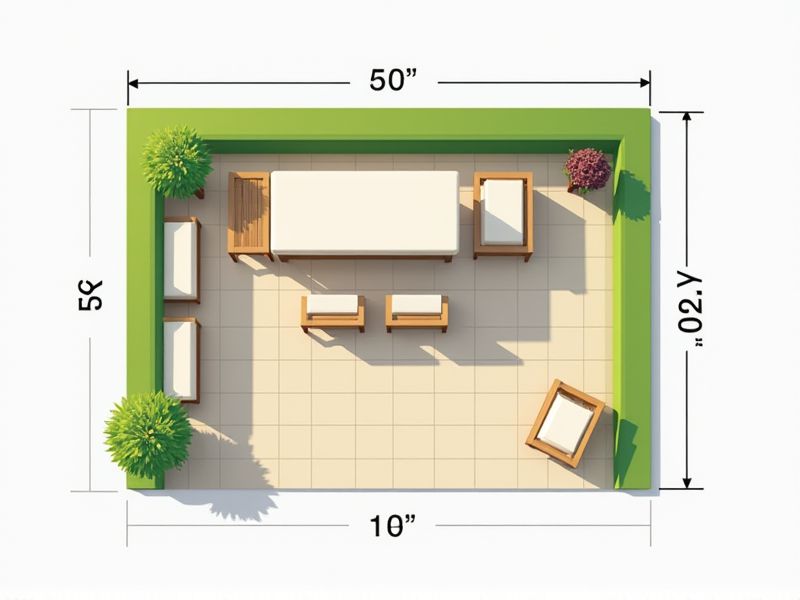
When planning an outdoor patio, common standard dimensions range from 12 feet by 12 feet for a small bistro space to 16 feet by 18 feet for a more comfortable, entertaining area. It's important to choose a size that fits your available yard space and intended use; for example, a 10-by-10-foot patio works well for a cafe table and two chairs, while a 16-by-20-foot setup accommodates a full dining set plus lounge seating. Allow at least 3 feet of clearance around furniture for easy movement. By considering these typical measurements, you can create a functional and inviting patio that enhances your outdoor living experience.
Furniture Layout Compatibility
When designing an outdoor patio, consider a furniture layout that promotes flow and accessibility, ensuring that each piece harmonizes with the space. Aim for a seating arrangement that accommodates at least four people, using modular furniture to adapt to varying group sizes. Incorporate a central table with a diameter of 36 to 60 inches for dining or socializing, allowing ample room for movement around it. Enhance the ambiance with strategically placed lighting, like string lights or solar-powered lanterns, increasing usability during evening hours and setting a cozy atmosphere.
Traffic Flow Maintenance
Effective outdoor patio design emphasizes traffic flow maintenance, ensuring a seamless movement of guests and minimizing congestion. A well-planned layout should incorporate at least 36 inches of clear walking space between furniture pieces to facilitate easy navigation. Incorporating durable materials like slip-resistant tiles or treated wood enhances safety in high-traffic areas, reducing the risk of slips and falls. Consider using designated paths, such as gravel or pavers, to guide foot traffic and create a more organized and inviting atmosphere.
Seating Capacity Optimization
When designing an outdoor patio, optimizing seating capacity is crucial for both comfort and functionality. Aim for a minimum of 15 square feet per person to ensure adequate space, fostering a relaxed environment. Strategically arranged furniture, such as modular seating or benches, can maximize the number of guests while maintaining accessibility. Consider including high-top tables, which can accommodate more people without taking up significant floor space, enhancing your patio's overall appeal.
Aesthetic Proportionality
Aesthetic proportionality in outdoor patios emphasizes the harmonious balance between design elements, space, and functionality. For instance, a well-proportioned patio can enhance the visual appeal of your garden or backyard, making it a perfect spot for gatherings or relaxation. The ideal dimensions often follow the golden ratio, where the length is about 1.618 times the width, promoting an inviting atmosphere. Incorporating materials like natural stone or wood in proportion to the vegetation around it further elevates the overall aesthetic, creating a seamless connection with nature.
Accessibility Compliance
Outdoor patios should meet specific Accessibility compliance standards to ensure inclusivity for all users. This includes a minimum width of 36 inches for pathways, enabling wheelchair access, and a slope not exceeding 1:12 for ramps. Clear signage must indicate accessible routes and features, while seating areas should include options with appropriate heights and spaces for wheelchair users. Implementing these standards not only enhances usability but also aligns with the Americans with Disabilities Act (ADA) regulations to create welcoming environments.
Safety Clearances
When designing an outdoor patio, it is essential to adhere to safety clearances to ensure a safe and enjoyable experience. The National Fire Protection Association (NFPA) recommends maintaining a minimum clearance of 3 feet between fire pits and any combustible materials, including furniture and overhanging structures. For structures such as awnings or trees, a vertical clearance of at least 10 feet is advisable to minimize fire hazards. Regularly inspect your patio area to ensure compliance with local building codes, which may require specific distances based on materials and usage.
Space Zoning Flexibility
Outdoor patios designed with a focus on space zoning flexibility can enhance your overall living experience. By incorporating movable furniture that adapts to various activities, you can create distinct areas for dining, relaxation, and entertainment within a compact footprint. Utilizing elements such as modular seating and adjustable canopies allows for easy transformation of your outdoor space, maximizing its usage throughout the seasons. Investing in multifunctional features, like built-in fire pits or storage benches, further optimizes the area, ensuring it meets your diverse needs.
Pergola Or Shade Structure Sizing
When considering outdoor patio designs, a pergola or shade structure typically requires a minimum height of 8 to 10 feet to ensure adequate clearance and comfort. The average coverage area can vary from 10x10 feet for smaller spaces to 20x20 feet for larger patios, allowing for flexible outdoor seating arrangements. If your patio accommodates more than four people, opt for a structure size of at least 12x12 feet to provide ample shade and protection from the elements. With proper sizing, you can enhance your outdoor experience while ensuring maximum sun protection and aesthetic appeal.
Complementing Landscaping Elements
A well-designed outdoor patio seamlessly integrates with landscaping elements, enhancing the overall aesthetic of your space. By utilizing natural materials such as stone or wood, you create a harmonious connection between the patio and your garden. The use of native plants not only complements your patio design but also promotes biodiversity, attracting beneficial wildlife. Aim for a patio layout that allows for at least 30% shaded areas, ensuring comfort during warm summer days and creating inviting spots for relaxation.
Weather Considerations And Durability
Selecting the right outdoor patio materials is essential for ensuring durability and weather resistance. For instance, composite decking can last up to 25 years, while natural wood typically requires regular maintenance and replacement every 10 to 15 years. Likewise, weatherproof furniture made from high-density polyethylene (HDPE) can withstand extreme temperatures and heavy rainfall, boasting a lifespan of over 20 years. In regions with frequent rain or snow, investing in rust-resistant metal fixtures can add an extra layer of protection against corrosion and extend the overall lifespan of your outdoor space.
